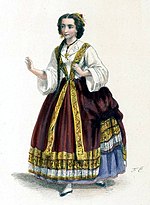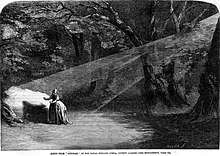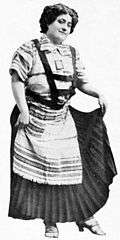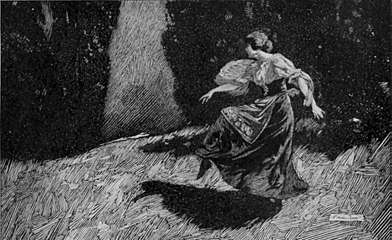Dinorah
Dinorah, originally Le pardon de Ploërmel (The Pardon of Ploërmel),[1] is an 1859 French opéra comique in three acts with music by Giacomo Meyerbeer and a libretto by Jules Barbier and Michel Carré.[2] The story takes place near the rural town of Ploërmel and is based on two Breton tales by Émile Souvestre, "La Chasse aux trésors" and "Le Kacouss de l'Armor", both published separately in 1850 in the Revue des deux mondes.[3]
| Giacomo Meyerbeer |
|---|
.jpg) |
|
Operas
|
Roles


.jpg)
| Role | Voice type | Premiere cast,[4] 4 April 1859 (Conductor: Meyerbeer) |
|---|---|---|
| Dinorah, a peasant girl | coloratura soprano | Marie Cabel |
| Shepherd | soprano | Breuillé |
| Shepherd | mezzo-soprano | Emma Belia |
| Corentin, a bag-piper | tenor | Charles-Louis Sainte-Foy |
| Goatherd | soprano | Dupuy |
| Goatherd | soprano | Marguerite Decroix |
| Hoël, a goat-herd | baritone | Jean-Baptiste Faure |
| A huntsman | bass | Barreille[5] |
| A harvester | tenor | Victor Warot |
| Loïc | baritone | Lemaire |
| Claude | tenor | Palianti |
| Chorus: peasants and villagers | ||
Synopsis
- Time: Nineteenth century
- Place: Brittany
Act 1
In the Breton village of Ploërmel ,a rugged and wild site illuminated by the last rays of the setting sun with, in the foreground, Corentin's cottage
During the annual pilgrimage to the chapel of the Virgin, Dinorah has gone mad because her bridegroom Hoël disappeared following a storm that interrupted their wedding on the same day the previous year. Dinorah has lost her pet goat Bellah but, believing she has found Bellah, she sings a lullaby to the goat and then walks away (Berceuse:Bellah, ma chèvre chérie). Hoël returns to the village, having discovered the whereabouts of a treasure. He enlists Corentin to help him recover the riches, but not without sinister intent, since according to the legend, the first to touch them will perish.


Act 2
Scene 1
A birch wood lit by the moon
Dinorah imagined she heard Hoël's voice and followed it into the wood, but once there, she weeps to find herself alone (Romance: Me voici, Hoël doit m’attendre ici). A moonbeam falls on her and casts its shadow on her feet. Imagining that it is the day before her wedding, she sings and dances with her shadow (Air: Ombre légère).
Scene 2
A mysterious valley
Hoël and Corentin descend upon the cache where Dinorah also happens to be. From her, Corentin learns about the legend, and later he and Hoël invite each other first to inspect the treasure. During that time, Dinorah, in pursuit of her pet goat, steps on a tree trunk by a river as it is hit by lightning, and falls in the water and is swept away by the current. Hoël having witnessed the scene leaps to her rescue.
Act 3
Hoël admits his love and regrets to Dinorah as she regains consciousness (Romance:Ah ! mon remords te venge). She recognizes him and regains her sanity. The villagers arrive and sing a hymn of forgiveness and lead the two lovers to the chapel where they will be married.
Performance history

The opera was premiered on 4 April 1859 by the Opéra-Comique at the second Salle Favart in Paris. The stage designs for acts 1 and 3 were by Edouard-Désiré-Joseph Despléchin and Jean-Louis Chéret.[6] Those for the more technically demanding act 2, which included onstage running water, were by Joseph and Karl Wilhelm Mühldorfer.[7]
The principal singers were highly acclaimed: "Marie Cabel for her vertiginous-virtuoso interpretation of Dinorah; Sainte-Foy for his overwhelmingly convincing characterization of Corentin, lyrically as well as dramatically; Jean-Baptiste Faure for his fascinating stage presence as Hoël, Meyerbeer's first big baritone role."[7] The supporting singers were also greatly admired, in particular, Barreille as the huntsman and Warot as the harvester. Meyerbeer's music was praised for its originality, but the libretto was found incomprehensible and even met with derision. In the initial run of performances up to the end of 1859, changes were made, the most significant being the casting of the contralto Palmyre Wertheimber in the role of Hoël.[7]
The opera remained very successful in Paris up to 1912.[8] Under its original title it was revived at the Opéra-Comique on 27 August 1874, 23 May 1881, 6 June 1896, and 16 March 1912,[8] by which time it had been performed over 200 times by the company.[4] It was revived in Brussels as late as 11 January 1939.[8]
Meyerbeer composed recitatives to replace the spoken dialog for performances abroad.[9] The opera was translated into Italian for the premiere in London on 26 July 1859 (with Miolan-Carvalho) and became known internationally as Dinorah, but it was first performed in America on 4 March 1861 at the French Opera House in New Orleans in French.[10]
Dinorah was performed in New York (at the Academy of Music) in Italian on 24 November 1862.[8] As a novelty, it attracted a great deal of attention and (starring the now nearly forgotten Angelina Cordier) was very popular. One of its attractions was to be the appearance of an actual, live goat on stage, which "inspired a vast dissemination of facetious goat-lore in all the papers."[11] Unfortunately, the opera followed close on the heels of a highly successful production of Bellini's Norma, and Meyerbeer's work suffered by comparison. The reviewer in Dwight's Music (6 December 1862) was highly critical, writing: "Beside such music as this (the heaviest of light operas), Bellini's melodies are golden and Rossini's operas classic." [12]
Nevertheless, Dinorah was initially performed quite often outside France and became a great favorite of Adelina Patti, but was rarely performed during the latter half of the 20th century except for the famous virtuoso aria for soprano "Ombre légère", also known as "The Shadow Song", in which Dinorah sings to and then dances with her shadow. Other sopranos who have enjoyed considerable success in the role of Dinorah include Amelita Galli-Curci, Ilma di Murska, Luisa Tetrazzini, Maria Barrientos, and Lily Pons.
- Illustrations from The Victrola Book of the Opera (1919)
 Tetrazzini as Dinorah
Tetrazzini as Dinorah "The Shadow Song"
"The Shadow Song" Galli-Curci as Dinorah
Galli-Curci as Dinorah
Although the opera has been largely neglected during the latter half of the last century, a rare broadcast performance of the overture by Arturo Toscanini and the NBC Symphony Orchestra from 12 November 1938, has been preserved.[13] This unusual overture has several sections with chorus, ample percussion, and has been compared favorably with those of Rossini and Verdi.
Meyerbeer's operas have become performed more often in Europe in the 21st century.[14] Dinorah received stagings in Dortmund and Parma in 2000 and in Compiègne in 2002.[14] A concert performance of the opera was given by the Deutsche Oper Berlin, in 2014, which was recorded.[15]
Dinorah was presented in full production by New York City's Amore Opera from March 19 to 23, 2019, at the Riverside Theatre.[16]
Recordings
Audio
- Dinorah – Deborah Cook (Dinorah), Christian du Plessis (Hoël), Alexander Oliver (Corentin) – Geoffrey Mitchell Choir, Philarmonia Orchestra – James Judd (conductor) – Opera Rara (1979)
- Dinorah – Patrizia Ciofi (Dinorah), Étienne Dupuis (Hoël), Phiippe Talbot (Corentin) – Chorus and Orchestra of Deutsche Oper Berlin – Enrique Mazzola (conductor) – cpo (2014)
- The aria "Ombre légère" has been recorded by many coloratura sopranos, including Maria Callas, Joan Sutherland, Anna Moffo, June Anderson and Natalie Dessay.
Video
- Isabelle Philippe (Dinorah), Armand Arapian (Hoël), Frédéric Mazzotta (Corentin) – Théâtre français de la musique, Cori Spezzatti, Orchestre de L’Opéra d’Etat Hongrais Failoni, Olivier Opdebeeck (conductor), Pierre Jourdan (adaptation and production) – Recorded in performance in October 2002 at the Théâtre impérial de Compiègne. Cascavelle DVDELD7000 (PAL, Region 0). OCLC 717423316. Kultur D4013 (NTSC, Region 1) ISBN 978-0-7697-7983-6.
Libretto and scores
Meyerbeer's manuscripts have not been found, and most published libretti reflect cuts to the score made in almost all productions. A complete libretto has recently been published by Cambridge Scholars Publishing as part of the series Giacomo Meyerbeer: The Complete Libretti in Eleven Volumes.[17] The following are the early printed sources which were used in the preparation of that libretto:
- Le Pardon de Ploërmel; opéra-comique en trois actes. Paris: Brandus & Dufour, 1859. (First edition of the full orchestral score with spoken dialogue.)
- Le Pardon de Ploërmel; opéra en trois actes. "Edition contenant les récitatifs et les morceaux ajoutés par l’auteur." Paris: Benoit, 1885. (Score with sung recitatives in place of spoken dialog.)
- Le Pardon de Ploërmel; opéra-comique en trois actes. Paris: Michel Lévy Frères, 1859. (Second edition of the libretto used for additional stage directions and scenic descriptions.)
References
Notes
- In France the opera is most often performed as Le pardon de Ploërmel. The translation "The Pilgrimage of Ploërmel" is by Huebner (1992)) and is not generally used as the title in English-speaking countries. Some revivals in France and most performances outside France have used the name Dinorah. Other French titles have included Le Pardon de Notre-Dame d'Auray and Les Chercheurs d'or (Wild & Charlton 2005, p. 353).
- Additions to the libretto were made in German by Meyerbeer and Charlotte Birch-Pfeiffer and translated into French by Georges-Frédéric Burguis and Joseph Duesburg respectively (Arsenty 2008, p. 1).
- Wild & Charlton 2005, p. 353; Letellier 2008, p. 187 (Letellier gives the title of the second story as "Le Kacouss de l'amour".)
- Wolff 1953, p. 135
- The real name of the bass singer using the stage name of Barreille was Alexandre-Maximilien Bonvoux (Letellier 2008, p. 241).
- Henze-Döhring 2004, p. 682 identifies the set designer Chéret as Jean Louis Chéret (1810–1882). Letellier 2008, p. 196 gives the name Jules Chérets (probably confusing him with the painter Jules Chéret).
- Letellier 2008, p. 196
- Loewenberg 1978, column 942
- Huebner 1992, p. 1180.
- Belsom 2007; Joyce & McPeek 2001. Loewenberg 1978, column 942 has the exact date and language, but not the venue. Note that Brown 2001, p. 576, and Belsom 1992, p. 584, say it was given at the Théâtre d'Orléans.
- Lawrence 1999, p. 514.
- Quoted in Lawrence 1999, pp. 514–515
- Wilson, John (2002). "Toscanini Discography". ToscaniniOnline.com. Archived from the original on 3 June 2010. Retrieved 7 November 2010.
- Letellier, Robert Ignatius (2006). The Operas of Giacomo Meyerbeer. Fairleigh Dickinson University Press. ISBN 978-0-8386-4093-7.
- Baker, David J. "Meyerbeer:Dinorah". operanews.com. Retrieved 9 September 2018.
- Simpson, Eric C. "New York Classical Review". newyorkclassicalreview.com. Retrieved 22 March 2019.
- Arsenty 2008, pp. 2–3.
Sources
- Arsenty, Richard, ed. (2008). The Meyerbeer Libretti: Opéra Comique 2 Le Pardon de Ploërmel. Cambridge Scholars. Introduction by Robert Letellier. Newcastle upon Tyne. ISBN 978-1-84718-969-1.
- Belsom, Jack (1992). "New Orleans" in Sadie 1992, vol. 3, pp. 584–585
- Belsom, Jack (2007). A History of Opera in New Orleans at the Wayback Machine (archived May 31, 2008)
- Brown, Clive (2001). "Giacomo Meyerbeer". In Amanda Holden (ed.). The New Penguin Opera Guide. New York: Penguin Putnam. pp. 570–577. ISBN 0-14-029312-4.
- Henze-Döhring, Sabine, ed. (2004). Giacomo Meyerbeer: Briefwechsel und Tagebücher, 1856–1859 (volume 7) (in German). Berlin: Walter de Gruyter. ISBN 978-3-11-018030-5.
- Huebner, Steven (1992). "Dinorah [Le pardon de Ploërmel ('The Pilgrimage of Ploërmel')]" in Sadie 1992, vol. 1, pp. 1179–1180
- Joyce, John; McPeek, Gwynn Spencer (2001). "New Orleans" in Sadie 2001
- Lawrence, Vera Brodsky (1999). Strong on Music: The New York Music Scene in the Days of George Templeton Strong. Volume III: Repercussions, 1857–1862. Chicago: University of Chicago Press. ISBN 9780226470160.
- Letellier, Robert Ignatius (2008). An Introduction to the Dramatic Works of Giacomo Meyerbeer: Operas, Ballets, Cantatas, Plays, p. 195. Hampshire, England: Ashgate. ISBN 978-0-7546-6039-2.
- Loewenberg, Alfred (1978). Annals of Opera 1597–1940 (third, revised ed.). Totowa, New Jersey: Rowman and Littlefield. ISBN 978-0-87471-851-5.
- Sadie, Stanley, ed. (1992). The New Grove Dictionary of Opera (4 volumes). London: Macmillan. ISBN 978-1-56159-228-9.
- Sadie, Stanley, ed. (2001). The New Grove Dictionary of Music and Musicians (2nd ed.). London: Macmillan. ISBN 978-1-56159-239-5. (hardcover), OCLC 419285866 (eBook), and Grove Music Online.
- Wild, Nicole; Charlton, David (2005). Théâtre de l'Opéra-Comique: Repertoire 1762–1972 (in French). Sprimont, Belgium: Mardaga. ISBN 978-2-87009-898-1.
- Wolff, Stéphane (1953). Un demi-siècle d'Opéra-Comique (1900–1950). Paris: André Bonne. OCLC 250469567, 459125672, 2174128.
Further reading
- Casaglia, Gherardo (2005)."Dinorah, 4 April 1859". L'Almanacco di Gherardo Casaglia (in Italian).
- Huebner, Steven (2008). "Dinorah" at Grove Music Online.
- Kobbé, Gustav; Harewood, Earl of (1958). Kobbé's Complete Opera Book. New York: Putnam. OCLC 560129867, 10720244, 637971238.
External links
- Le pardon de Ploërmel: Scores at the International Music Score Library Project (IMSLP) (Includes vocal scores in French and Italian.)
- Act 2, storm scene on YouTube, Amore Opera, New York City, 2019